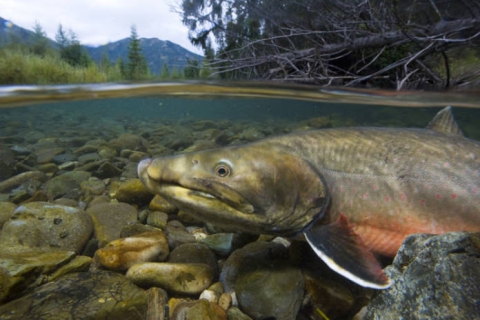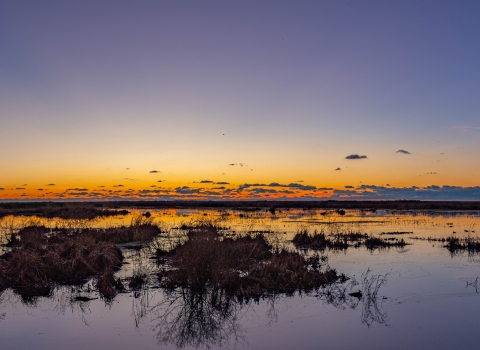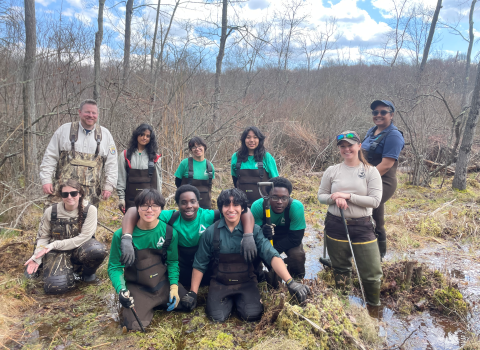By Jan Peterson, for the U.S. Fish and Wildlife Service
Washington’s Snoqualmie Pass has always served as a trade route. Tribes traveled the pass for trade, hunting and fishing. It evolved over time from foot paths to wagon ruts to paved roads.
The trade route underwent its greatest transformation when then President Dwight D. Eisenhower signed into law the Federal-Aid Highway Act of 1956, which created the U.S. system of interstate highways that includes Interstate 90.
“There’s a reason there’s an interstate there, because it always has been from time immemorial. The west side liked the Yakima Basin fish because they were fatter,” said Mitch Long, executive director of Kittitas Conservation Trust, based in Roslyn, Washington.
But in building I-90, contractors also introduced a host of problems for fish and other wildlife species that depend on the habitat in the region to survive. Migration pathways were cut off along with the cold, clear water anadromous fish must have to survive.
Today, that area, about a 55-mile drive along I-90 from Seattle, is about to experience another massive transformation, one that will reopen those pathways of wildlife migration and return the cold, clear water that the Endangered Species Act-listed bull trout and other anadromous fish need to survive. Thanks to a $5 million grant from the National Fish Passage Program with funds made available through the Bipartisan Infrastructure Law Bipartisan Infrastructure Law
The Bipartisan Infrastructure Law (BIL) is a once-in-a-generation investment in the nation’s infrastructure and economic competitiveness. We were directly appropriated $455 million over five years in BIL funds for programs related to the President’s America the Beautiful initiative.
Learn more about Bipartisan Infrastructure Law , the Gold Creek Valley Restoration Project is expected to break ground in summer 2025. The BIL money along with in-kind matches provides the $8.4 million toward instream restoration work for 2.5 miles of streambed. The project will limit dewatering and disconnection of the river. This will reduce stranding and allow upstream passage of adult bull trout to their spawning habitat in summer. The entire project is expected to cost about $50 million. When completed, it will open 8 miles of upstream habitat, reconnect 245 acres of floodplain, and restore recreation opportunities at a beautiful and beloved site.
The Gold Creek Valley Restoration Project is a partnership between the Kittitas Conservation Trust, the Confederated Tribes and Bands of the Yakama Nation, U.S. Forest Service, and several programs within the U.S. Fish and Wildlife Service, including Fish and Aquatic Conservation, Ecological Services and Partners for Fish and Wildlife, along with many other federal and state groups and private landowners.
“The Gold Creek Valley Restoration Project represents a unique, landscape-level opportunity to restore habitat across ownership boundaries. Thanks to partners and private landowners working together, we can save a bull trout population that’s close to dying out,” said Kathryn Furr, Yakima Basin Integrated Plan Coordinator for the U.S. Forest Service, in Winthrop, Washington.
“The project started with this idea that the creek goes dry due to human impacts, so we started monitoring groundwater and surface water to see where the water was going and why it’s leaving Gold Creek,” said Katy Pfannenstein, fish biologist and Gold Creek project lead with the Habitat Restoration and Conservation Program at the Service’s Mid-Columbia Fish and Wildlife Conservation Office, in Leavenworth, Washington.
Project partners made an important discovery about 10 years ago, Pfannenstein said. “We discovered the large gravel borrow pit used to build I-90 is pulling water from the creek because of how physics works. It was never restored.”
Instead of returning to Gold Creek, which is designated critical habitat for bull trout, the water is trapped in the human-created pit, preventing it from going where it is direly needed.
Furr explains the problem further: “Gold Creek originates in the Alpine Lakes Wilderness and provides cold water that is key for species to persist in the face of climate change climate change
Climate change includes both global warming driven by human-induced emissions of greenhouse gases and the resulting large-scale shifts in weather patterns. Though there have been previous periods of climatic change, since the mid-20th century humans have had an unprecedented impact on Earth's climate system and caused change on a global scale.
Learn more about climate change . We have an opportunity to re-create the function of the stream and undo the harm humans caused to this area.”
Adding to the problem is that logging and removing old-growth trees doubled the width of Gold Creek’s channel, leaving it far too wide and with less riparian riparian
Definition of riparian habitat or riparian areas.
Learn more about riparian zone, so the water is spread out over more surface. Juvenile bull trout get caught in little pools and adult bull trout cannot migrate to spawning areas as the creek dewaters.
“With the creek going dry, there are isolated pools that little baby fish get stuck in, so Yakama Nation and Washington Department of Fish and Wildlife folks scoop up the fish to save them so they don’t dry out or get eaten by birds or are predated on in these little pools that will dry up,” Pfannenstein explained.
Fish are released into the reservoir the following year. At the time of release, juvenile bull trout are approximately 250 millimeters (9.8 inches) in length.
To fix the problem, Kittitas Conservation Trust with the assistance of the Service will supervise contractors who will refill the borrow pit and restore Gold Creek to its natural wetland landscape using helicopters and ground-based equipment. “When you’re doing restoration, it’s not flat. A lot of artistic creativity is involved. What do you think the river wants to do with this log?” Long said. More than 140 engineered logjams will be reintroduced to the streambed, and the riparian habitat will be restored.
Long said now is the time to save the remaining bull trout populations in the Yakima Basin. Diversity means resiliency. Three populations in the Yakima Basin have already been lost. At one time, there were at least a dozen in the basin.
“Bull trout, they’re kind of the unsung hero of fish in the cold-water realm,” Long said. “Bull trout for a long time were kind of persecuted – they ate salmon, they were a predator. They’re the epitome of what a trout or salmon species should be, but no one thinks about them. From my perspective, if bull trout go, it’s the canary in the coal mine.”
Mel Babik, Kittitas Conservation Trust’s restoration director, said watching other experts plan on how to restore the area to its natural state has been fascinating. “It’s amazing working with these top-tier botanists,” she said. “They want not only native plants, but genetic-specific stock that are getting their start on a nurse log.”
The project transcends even bull trout, Babik said. “Restoration is different. You’re holistically improving this environment. What I love about this restoration project is we’re restoring for whatever comes next.”
Furr added: “The Gold Creek Valley Restoration Project represents a truly transformational project. Fisheries agencies are poised to reintroduce salmon and steelhead above Keechelus Dam after an absence of over 100 years. Gold Creek will be the primary spawning tributary for these restored runs of anadromous fish, bringing benefits to bull trout, spring Chinook salmon, sockeye salmon and ESA-listed steelhead. The project will reestablish stream flow and historic wetlands; reduce the risk of flooding to private land; and implement activities across ownership boundaries to bring about restoration at a landscape scale.”
The Gold Creek Valley Restoration Project has been named as one of 10 Transformational Fish Passage Projects across the nation. Learn more about these projects in this interactive story map.
Our public lands, like our roads and bridges, require strategic investments and management to protect the fish and wildlife that is so important to the American public. The Bipartisan Infrastructure Law has committed $455 million to the U.S. Fish and Wildlife Service over five years to support our natural infrastructure and protect these valuable resources. This is a once-in-a-generation investment that will help local, state, and Tribal communities tackle the climate crisis while creating jobs, and boosting local economies. By funding efforts to address intensifying drought, wildfires, flooding and legacy pollution, the law is the largest investment in the resilience of physical and natural systems in American history. Together we will build back better ecosystems and protect wildlife and wild spaces for the next generation.






